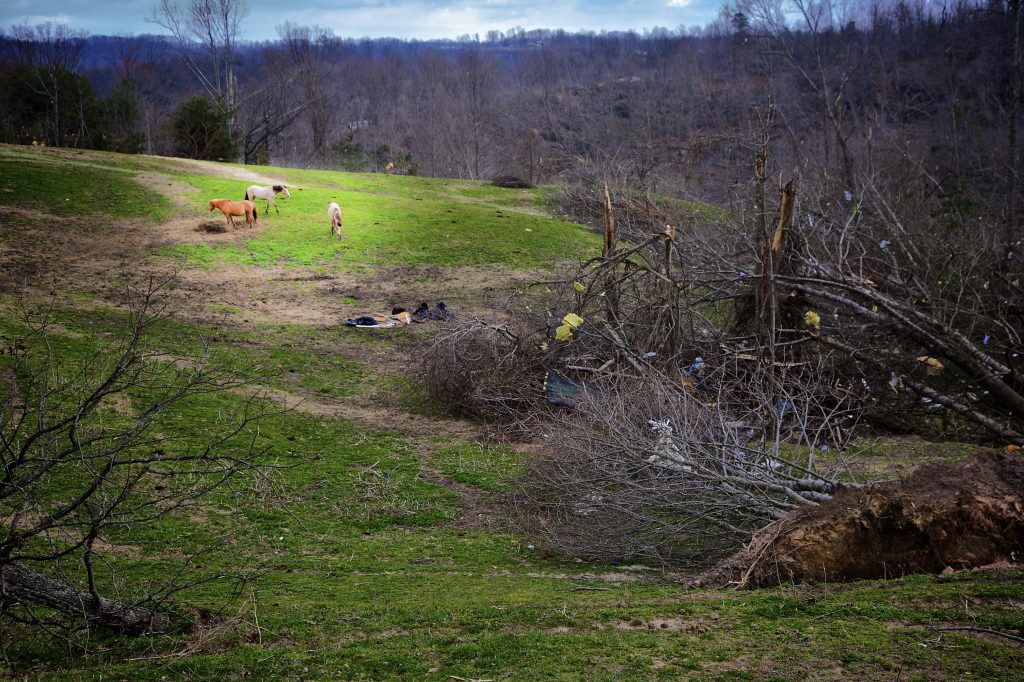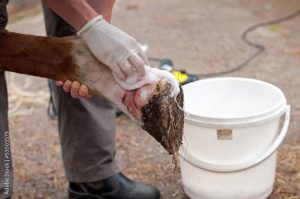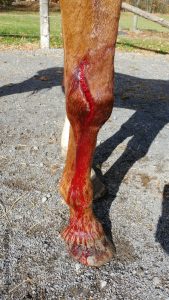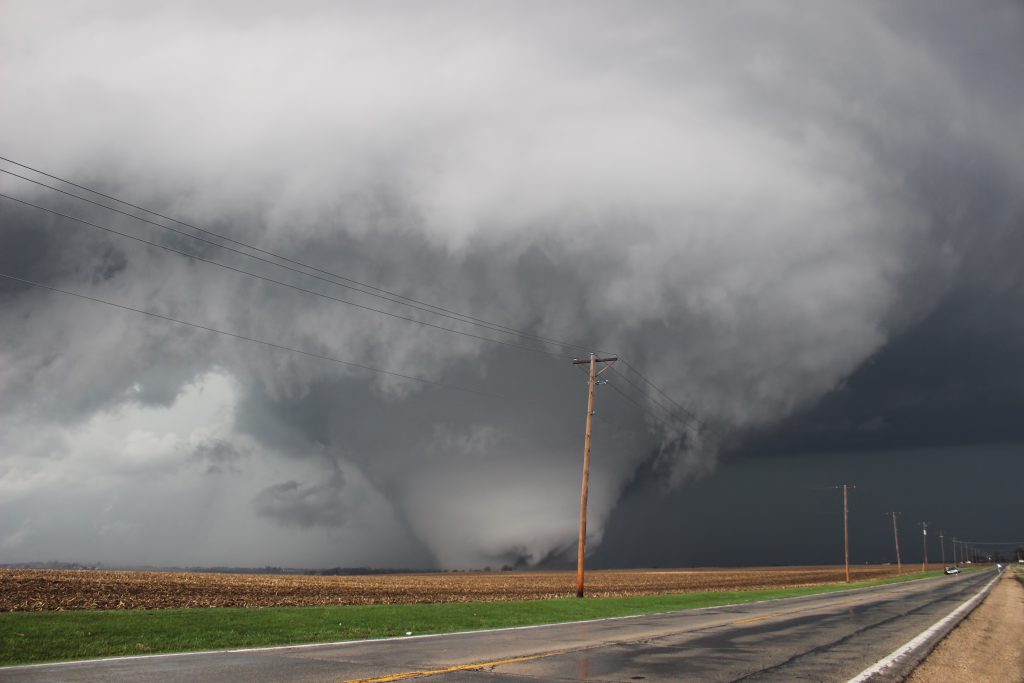Navigating the decision-making process of how to best protect your horses when a severe storm is heading your way. Major storms with vicious tornados regularly attack the south-central region of the United States, but the events of the past several years have shown that there is really no region safe from the spinning vortices.

So, what can we as horse owners do to prepare for such an event, and then how do we decide a course of action when a storm is imminent?
Take Action Now

Preparation is key. The first and most important step horse owners can take is to start planning now.
According to Dr. Julie White of White Equine in Purcell, Oklahoma, the most common injuries she sees post-storm are lacerations from flying debris. “Ensuring that your barn, paddocks, and entire facility are as secure as possible is important. Take time to secure loose boards or panels, and remove any other debris or items that could injure your horse,” she said.

White, who has treated many horses after severe storms, was adamant that preparation and planning is key for any severe weather situation.
“More than anything, you have to have a plan. When a storm is blowing in is not the time to make these major decisions; it’s the time to execute the plan you’ve already created,” she explained.
White added that developing a good relationship with a couple veterinarians near your home is important, as is considering transportation for your horses. “You need to know who you’ll contact if you have an injury, and in an emergency, there might be several people trying to do the same thing, so the vets might be tied up in one location and you’ll have to travel to them. When the Moore (Oklahoma) tornados happened, many times the vets couldn’t get to them, and many had to travel to the hospital,” she explained. “You need to consider if you have enough vehicles and trailers to haul your horses. If you don’t have a truck and trailer to haul your horses, make sure you know who you can call in a pinch.”
Keeping a stocked first aid kit in a secure location is crucial, not only for small, treatable wounds, but also to stabilize a horse while waiting for the veterinarian or hauling to one.
Where is the Safest Place for Your Horse During a Storm
The short answer, according to White, is that it depends.
“It depends on the full extent and type of weather that is coming, your facilities, what your horse is used to, and how much time you have before the storm hits,” she said.
The decision is typically between keeping your horse up in the barn, or turning them out in a field, but making the right choice might seem like luck of the draw.
The first factor is the type of storm coming, and the size and scope of it. “If you have a thunderstorm with significant wind or lightning, keeping your horse in a barn is going to provide more protection from flying debris or lightning strikes. Plus, that keeps your horse in an environment you’re used to,” White said.
Barn structure is also key, as barns made of brick and concrete, or those with an exceptionally secure design, might offer enough protection for even smaller tornados, such as F0 and F1.
“Keeping your animal in an environment where they can get shelter, where it is a familiar environment, usually helps them weather a storm much better,” White said. “I prefer that they’re staying with their usual buddies that they’re used to.”
Of course, if a significant tornado event is happening, with large and damaging tornados, it’s not going to matter, as most above-ground structures won’t hold with a direct hit.
Many experts advocate turning your horse out in the event of a direct hit if you have plenty of acreage and spaces without fences, believing that allowing the animal to use their instincts to seek shelter or run will give them the best chance for survival, especially if the barn or shelter structure is in danger of collapse.
If you’re in a situation in which turning your horses loose is the best course of action, make sure they can be easily identified.
“I recommend the neckbands that we typically use on recipient mares for identification. They are plastic and have a lower chance of getting stuck on something, but you can write a lot of information on those bands that won’t easily wash away,” White said. “I know some people will braid or tape information in their horses’ manes, which can work as long as it is written on something that will still be readable after being out in the rain.”
It’s also important to have photos from multiple angles of your horse, especially of any distinguishing characteristics.
Making sure your horse is easily identifiable, and knowing how to reclaim your animal is important.
Every county or city should have an emergency manager. While they’ll typically deal with the human side of things, they will oversee all operations, and there will be a variety of entities that play a part in disaster response. Make sure you know that system, and how it works, to increase your chances of getting your animal back.
Great resources for preparing for natural disasters and other information related to livestock and farm preparedness are FEMA, ready.gov, the Extension Disaster Educator Network, and the Animal and Plant Inspection Service.
As difficult as it may be, the most important thing to remember is that human life comes first, and to not put yourself in anymore danger than necessary when dealing with mother nature. By nature, horses are flight animals with incredible instincts when it comes to survival.
The Tornado Ranking Scale and What to Expect

The Fujita Scale (or F Scale) of tornado damage intensity was developed based on damage intensity and not wind speed; wind speed ranges given are estimated, based on the extent of observed damage.
Across all of history, weak F/EF0 and F/EF1 tornadoes have comprised about 80 percent of all twisters. F/EF2 make up about 14 percent, F/EF3 roughly four percent, F/EF4 nearly one percent, and F/EF5 the miniscule 0.1 percent.
F0 – (Wind Speed 40 to 72 mph) Light Damage. Some damage to chimneys; branches broken off trees, shallow-rooted trees uprooted, sign boards damaged.
F1 – (Wind Speed 73 to 112 mph) Moderate damage. Roof surfaces peeled off; mobile homes pushed foundations or overturned; moving autos pushed off road.
F2 – (Wind Speed 113 to 157 mph) Considerable damage. Roofs torn from frame houses; mobile homes demolished; boxcars pushed over; large trees snapped or uprooted; light objects become projectiles.
F3 – (Wind Speed 158 to 206 mph) Severe damage. Roofs and some walls torn from well- constructed houses; trains overturned; most trees in forested area uprooted; heavy cars lifted and thrown.
F4 – (Wind Speed 207 to 260 mph) Devastating damage. Well- constructed houses leveled; structures with weak foundation blown some distance; cars thrown; large missiles generated.
F5 – (Wind Speed 261 to 318 mph) Incredible damage. Strong frame houses lifted off foundations, carried considerable distances, and disintegrated; auto-sized missiles airborne for several hundred feet or more; trees debarked.
